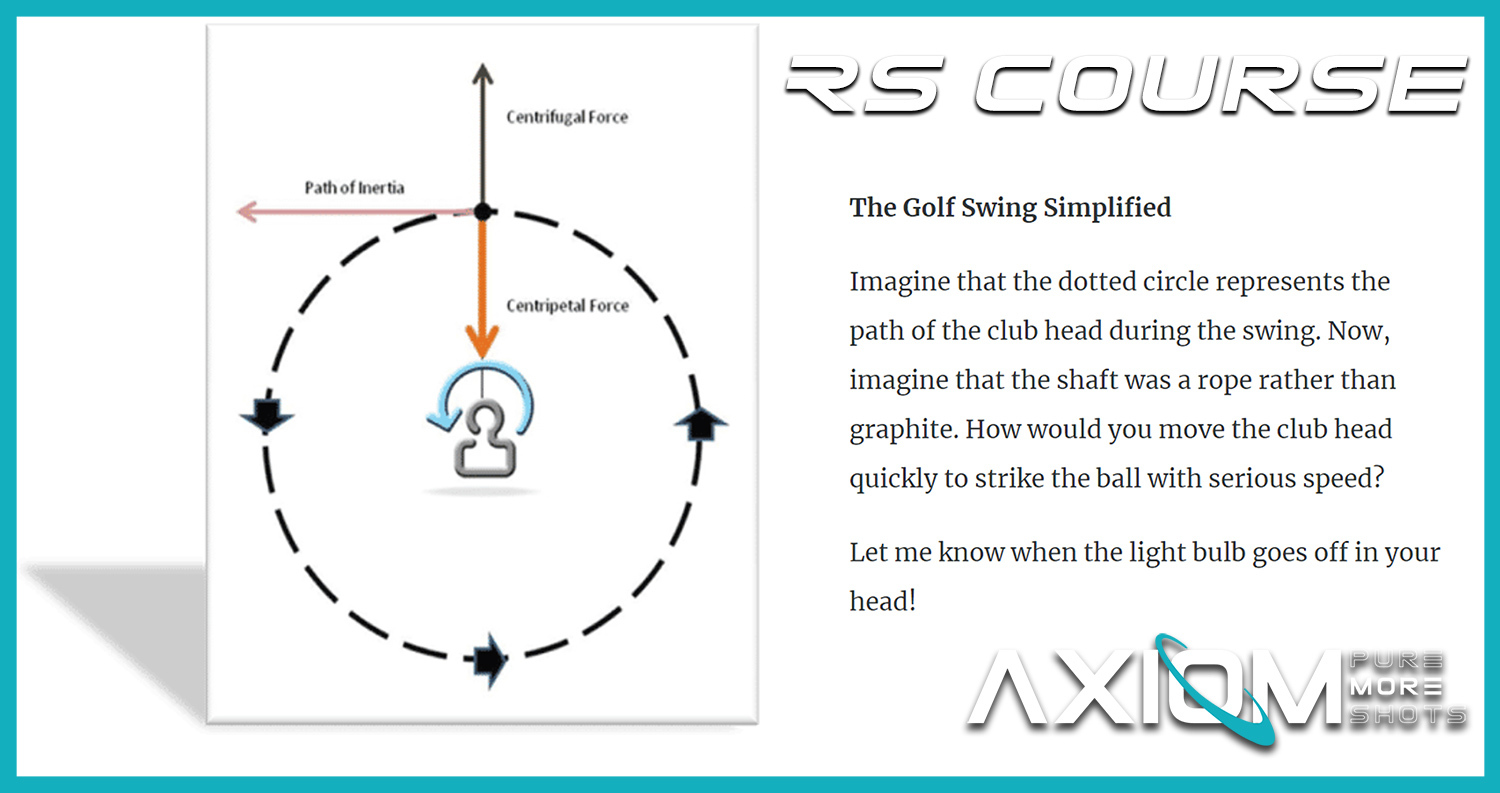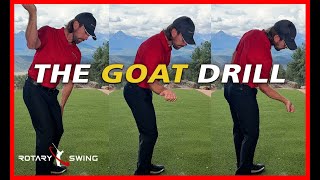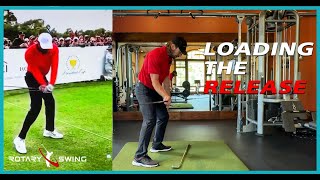Watch part 2 now to see how you're moving your body in the opposite direction of the pros!
Today we're going to talk about what we like to call "swing glue." It's what holds your swing together and allows you to hit great shots even if your technique isn't perfect.

Rock back & forth
Swing glue is made up of two things: balance and rhythm.
Great balance and great rhythm allow you to get away with a lot. You may make a couple of wrong moves, not get into just the right positions with arms, elbows, knees, etc., but you'll still hit some fantastic shots.
Conversely, if you don't have good balance and rhythm, you're going to hit bad shots even if you do have perfect technique.
We're obviously not trying to say technique isn't important; it's incredibly important, but balance and rhythm are equally critical.
If you combine great technique and great balance and rhythm, you'll hardly ever be beat!
Find Your Center of Gravity
There's an incredibly simple training aid that can help you develop these skills.
Pick up a simple wooden dowel for a couple of bucks at the hardware store - Clay is using a 5/8" dowel in these photos - for some instant feedback when you're working on balance and rhythm.

Center of gravity falls into a range
The first thing you can do with your new training aid is practice getting into balance between your heels and toes. You want to be very centered, from front to back.
In previous lessons on finding your true balance we talked about rocking forward and back to find your body's natural balance point.
Your center of gravity, and your natural balance point, should be somewhere between your ankle bone and a few inches forward of that. Imagine this range as a kind of "green zone" for your weight distribution throughout the swing.
The exact location of your center of gravity will depend on your build, but if you lay the dowel on the ground just in front of the heel of your shoe, that should be about where your weight will be centered.
Rock gently back and forth to find your balance point, where the weight is evenly distributed between your heels and toes.
Maintain That Center Throughout the Swing
You want to keep your body very balanced as you make your backswing.

Over rotation: Knee straightens & weight shifts too far back
You should feel like your weight is evenly distributed between your heels and toes on the rod as you swing back. Paying attention to your weight distribution will help you get into a fairly good position at the top of the backswing.
One way we see people get this wrong is by letting the hips over rotate.
When the hips rotate too far, the right knee straightens and, as you can see in the photo, the weight shifts too far back, ending up on the ankle or heel.
Standing on the rod provides instant feedback if you do this because if your weight shifts back you'll feel yourself letting pressure off the rod.
Another thing nearly everyone has struggled with at one time or another is maintaining posture through impact.
Focus on keeping your weight centered on the rod as you swing down - don't get too far onto heels or toes - to stay in posture as you come into impact.

Getting weight onto toes shifts hips forward
The most common mistake we see - something almost everyone does in an effort to gain power - is rushing the top of the swing. They let their weight go to their toes, causing their hips to shift forward toward the ball.
Probably 9 out of 10, if not 10/10 golfers has done this at some point. It causes you to come out of your posture, as Clay demonstrates in the photo at left.
It all comes from letting your weight shift forward and your hips spin open. Again, it's an effort to get a lot of power from the top of the swing.
You can solve this problem by simply making sure to keep your weight centered on the rod as you swing down. Don't let it go to your heels or toes and you'll stay in perfect posture through the swing.
Correct Even More Faults from Face On
Let's turn to the face on view to correct even more swing faults with the humble dowel.

The rod helps you feel your weight shift
Start out by finding your proper stance width and marking it on the rod. Just get a magic marker and draw a line at the inside of each foot so you can automatically get into proper stance width without even thinking about it any time you work with the rod.
As you discovered in the balance exercises above, standing on the rod makes you more aware of your weight distribution. You can feel which foot, and even which part of the foot, is bearing your weight.
Your weight is centered between the feet at address, and shifts smoothly to the inside of the right foot on the backswing.
You're only actually moving about an inch, but your weight is transferred to the inside of the right foot. The rod will help you feel that your weight is not only centered from heel to toe, but that it's also balanced on the inside of the foot.
We saw above that keeping your weight correctly balanced from front to back helps solve two problems: over rotating the hips on the backswing, and coming out of your posture at impact.
Shifting your weight properly corrects several more swing faults.

Smooth weight shift from the inside of the right foot to the center of the left (center) helps prevent swing errors such as reverse pivot (left) and sway (right)
For instance, as you can see in the photo on the left above, a reverse pivot gets too much weight on the left foot, and rolls the right foot to the outside. You definitely won't have any weight on the inside of the right foot when you're leaning back like that - you'll be more concerned with trying to stay upright!
Swaying to the right on the backswing, like in the photo on the right, will also cause you to feel a lot of weight on the outside of the right foot.
In the downswing, your weight needs to shift very smoothly from the inside of the right foot to the center of the left foot, as shown in the two center photos.
Getting Into Neutral
When you're in proper impact position, about 90% of your weight will be on the center of your left foot. It's easy to tell if you've achieved that when you're standing on the rod.
Getting your weight on that left foot puts you into neutral joint alignment, as shown in the photo at left below. That means your left ankle, hip, and shoulder are all stacked on top of each other, allowing your body to move the way it's designed to.
Once you get into neutral joint alignment by getting the weight on the center of the left ankle, you can rotate freely on the left hip without fear of damaging it.

Neutral joint alignment allows the left hip to rotate safely. Rotating after sliding the hip out (right) would damage the hip joint
If you let the hip slide out, it ends up too far forward. You will feel your weight too far forward on the left foot, and when you try to rotate, the hip bone will grind into the hip socket, causing damage.
Do that too often and you'll have a very sore left hip. If you get into the classic Reverse C position like a lot of the pros from the '60s and '70s and hit all your shots like that, you could even end up with a hip replacement, down the road.
Get Rhythm
Throughout the swing, you're focusing on starting with your weight centered, moving to the inside of the right foot on the backswing, and then moving back to the center of the left foot on the downswing. You're also making sure to keep it balanced between heels and toes.
Once you're able to get your weight in the right place through the swing, you can begin to practice shifting it rhythmically.
All of your weight transfers should be nice and smooth. You don't want to get to the top and then shove everything over to the left. Just try and develop a nice, smooth rhythm.
This simple dowel will probably cost your $2.50 or so, but it will help you with about six or seven different things in your swing, between the balance and timing and problems it solves. It's a great way to develop some "swing glue," so you can hit a lot of great shots even if your technique isn't perfect.
















































































































































































































































































































































































































































































 Rock back & forth
Rock back & forth Center of gravity falls into a range
Center of gravity falls into a range Over rotation: Knee straightens & weight shifts too far back
Over rotation: Knee straightens & weight shifts too far back Getting weight onto toes shifts hips forward
Getting weight onto toes shifts hips forward The rod helps you feel your weight shift
The rod helps you feel your weight shift Smooth weight shift from the inside of the right foot to the center of the left (center) helps prevent swing errors such as reverse pivot (left) and sway (right)
Smooth weight shift from the inside of the right foot to the center of the left (center) helps prevent swing errors such as reverse pivot (left) and sway (right) Neutral joint alignment allows the left hip to rotate safely. Rotating after sliding the hip out (right) would damage the hip joint
Neutral joint alignment allows the left hip to rotate safely. Rotating after sliding the hip out (right) would damage the hip joint